NCERT Exemplar Class 11 Maths Chapter 5 Complex Numbers and Quadratic Equations are part of NCERT Exemplar Class 11 Maths. Here we have given NCERT Exemplar Class 11 Maths Chapter 5 Complex Numbers and Quadratic Equations.
NCERT Exemplar Class 11 Maths Chapter 5 Complex Numbers and Quadratic Equations
Short Answer Type Questions
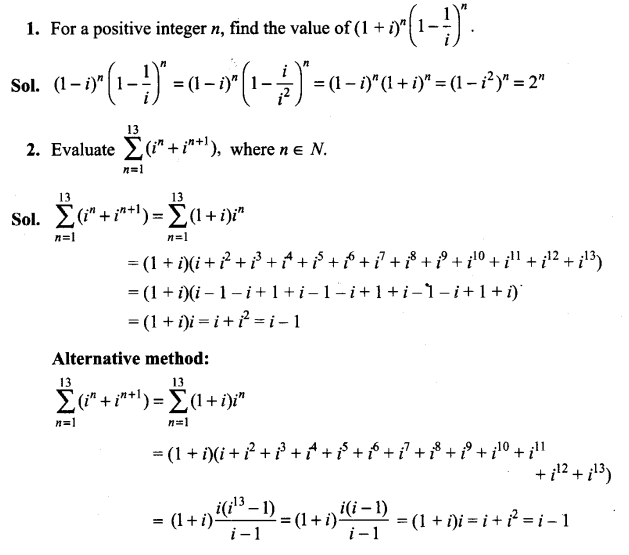

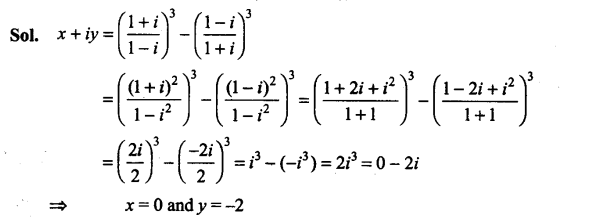
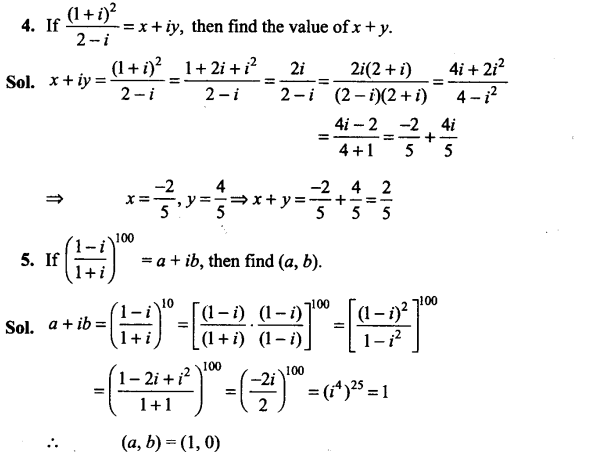
Q6. If a = cos θ + i sin θ, then find the value of (1+a/1-a)
Sol: a = cos θ + i sin θ

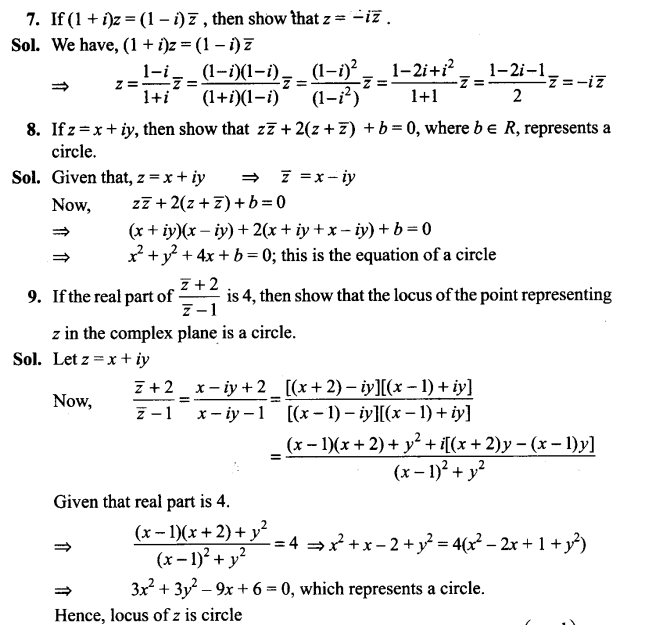
Q10. Show that the complex number z, satisfying the condition arg lies on arg (z-1/z+1) = π/4 lies on a circle.
Sol: Let z = x + iy

Q11. Solve the equation |z| = z + 1 + 2i.
Sol: We have |z| = z + 1 + 2i
Putting z = x + iy, we get
|x + iy| = x + iy + 1+2i
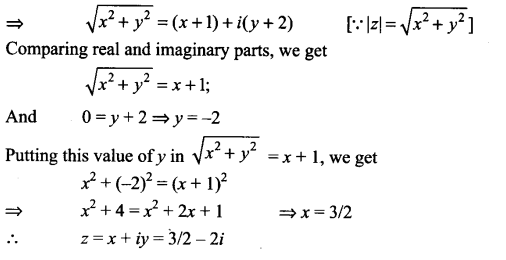
Long Answer Type Questions
Q12. If |z + 1| = z + 2( 1 + i), then find the value of z.
Sol: We have |z + 11 = z + 2(1+ i)
Putting z = x + iy, we get
Then, |x + iy + 11 = x + iy + 2(1 + i)
⟹|x + iy + l|=x + iy + 2(1 +i)
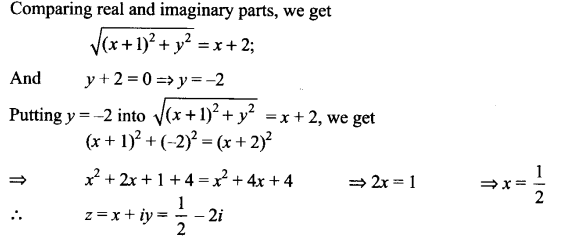
Q13. If arg (z – 1) = arg (z + 3i), then find (x – 1) : y, where z = x + iy.
Sol: We have arg (z – 1) = arg (z + 3i), where z = x + iy
=> arg (x + iy – 1) = arg (x + iy + 3i)
=> arg (x – 1 + iy) = arg [x + i(y + 3)]


Q14. Show that | z-2/z-3| = 2 represents a circle . Find its center and radius .
Sol: We have | z-2/z-3| = 2
Puttingz=x + iy, we get
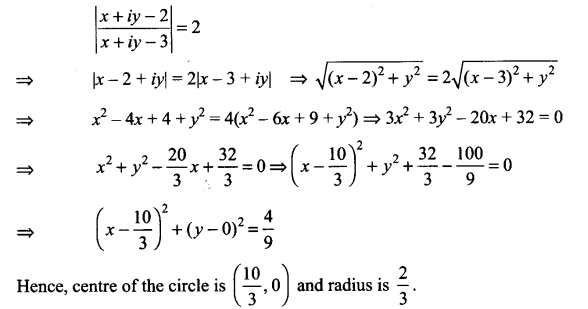
Q15. If z-1/z+1 is a purely imaginary number (z ≠1), then find the value of |z|.
Sol: Let z = x + iy
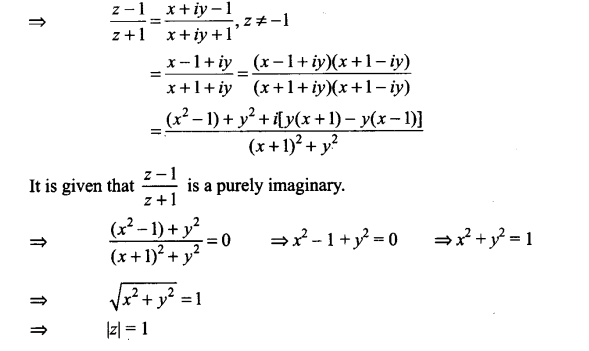
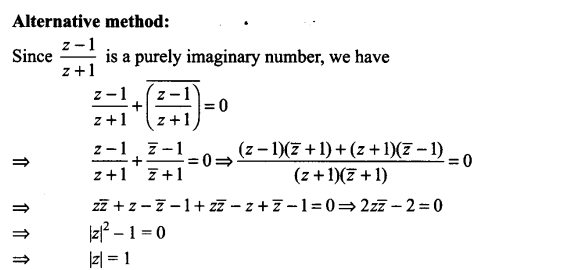
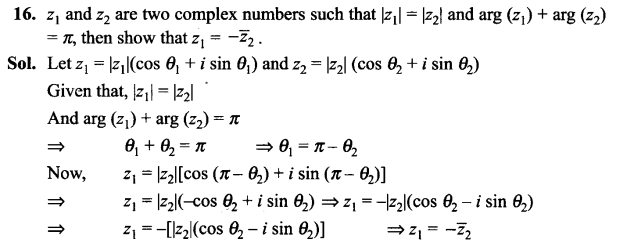
Q17. If |z1 | = 1 (z1≠ -1) and z2 = z1 – 1/ z1 + 1 , then show that real part of z2 is zero .

Q18. If Z1, Z2 and Z3, Z4 are two pairs of conjugate complex numbers, then find arg (Z1/ Z4) + arg (Z2/ Z3)
Sol. It is given that z1 and z2 are conjugate complex numbers.
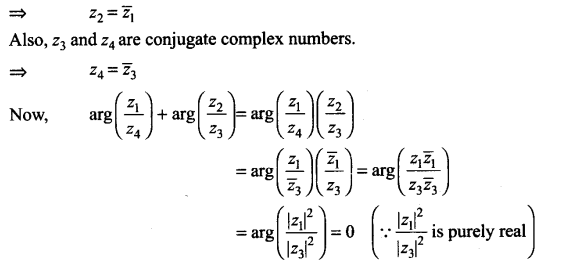
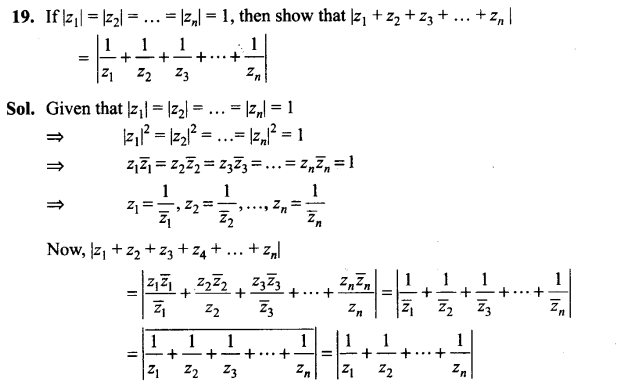
Q20. If for complex number z1 and z2, arg (z1) – arg (z2) = 0, then show that |z1 – z2| = | z1|- |z2 |
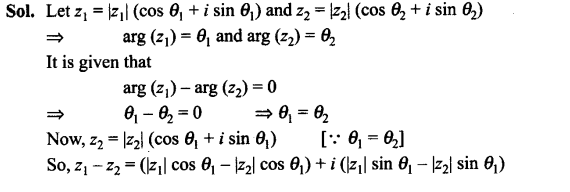
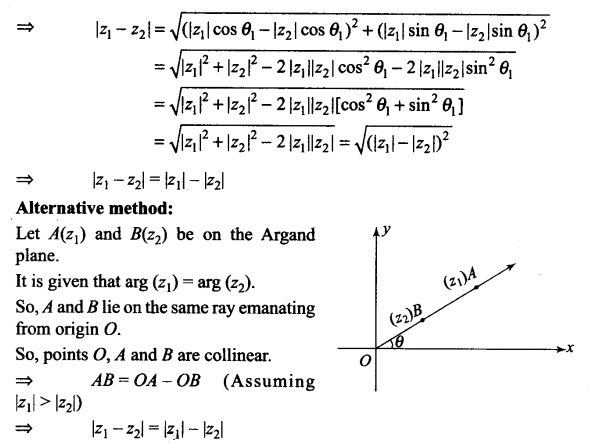
Q21. Solve the system of equations Re (z2) = 0, |z| = 2.
Sol: Given that, Re(z2) = 0, |z| = 2
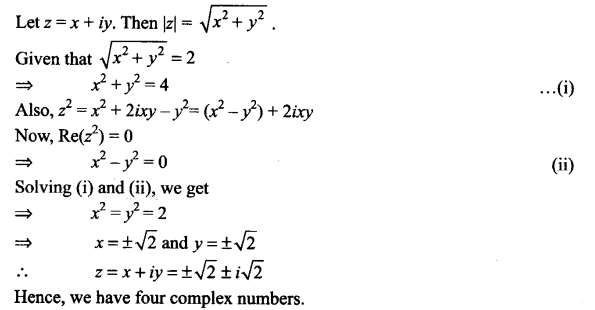
Q22. Find the complex number satisfying the equation z + √2 |(z + 1)| + i = 0.
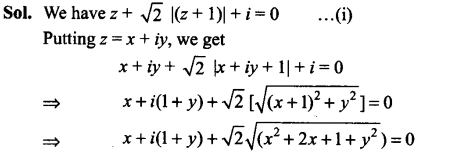

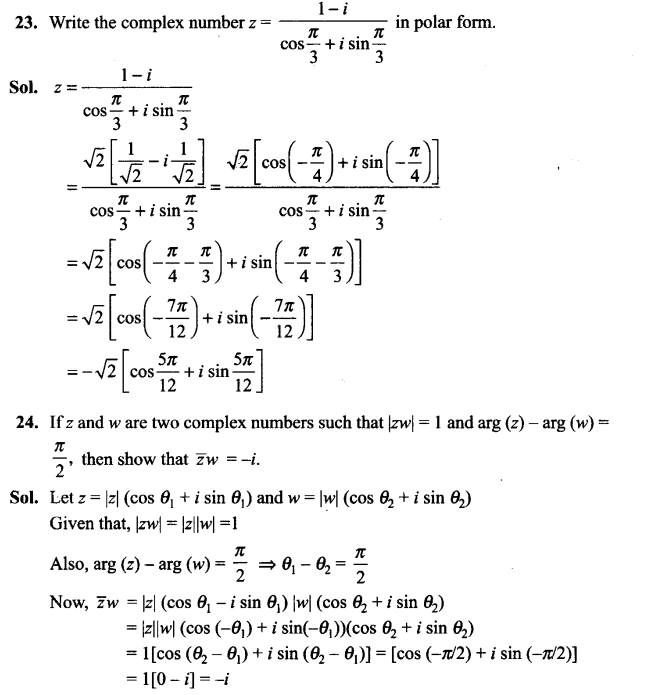
Fill in the blanks

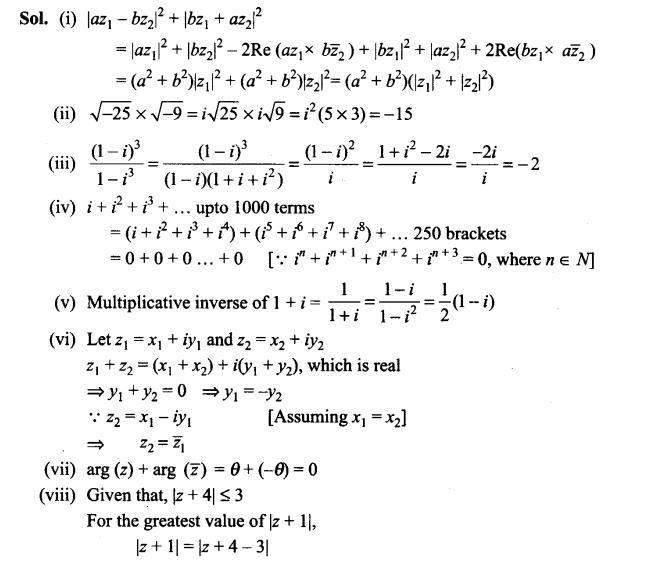
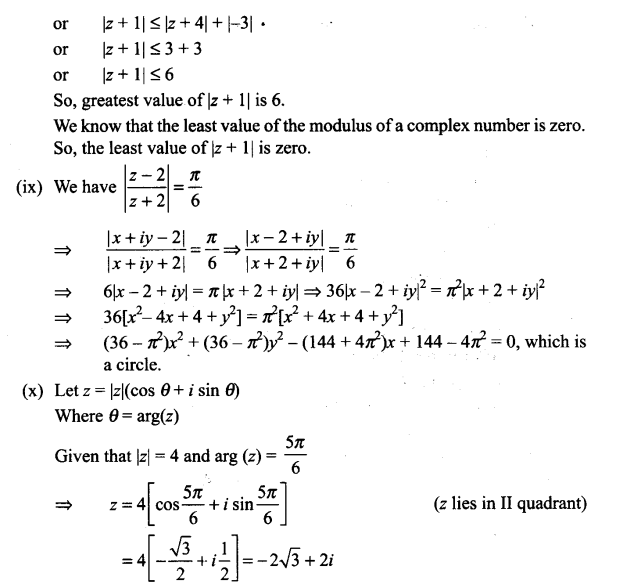
True/False Type Questions
Q26. State true or false for the following.
(i) The order relation is defined on the set of complex numbers.
(ii) Multiplication of a non-zero complex number by -i rotates the point about origin through a right angle in the anti-clockwise direction.
(iii) For any complex number z, the minimum value of |z| + |z – 11 is 1.
(iv) The locus represented by |z — 11= |z — i| is a line perpendicular to the join of the points (1,0) and (0, 1).
(v) If z is a complex number such that z ≠ 0 and Re(z) = 0, then Im (z2) = 0.
(vi) The inequality |z – 4| < |z – 2| represents the region given by x > 3.
(vii) Let Z1 and Z2 be two complex numbers such that |z, + z2| = |z1 j + |z2|, then arg (z1 – z2) = 0.
(viii) 2 is not a complex number.
Sol:(i) False
We can compare two complex numbers when they are purely real. Otherwise comparison of complex numbers is not possible or has no meaning.
(ii) False
Let z = x + iy, where x, y > 0
i.e., z or point A(x, y) lies in first quadrant. Now, —iz = -i(x + iy)
= -ix – i2y = y – ix
Now, point B(y, – x) lies in fourth quadrant. Also, ∠AOB = 90°
Thus, B is obtained by rotating A in clockwise direction about origin.
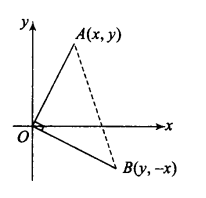


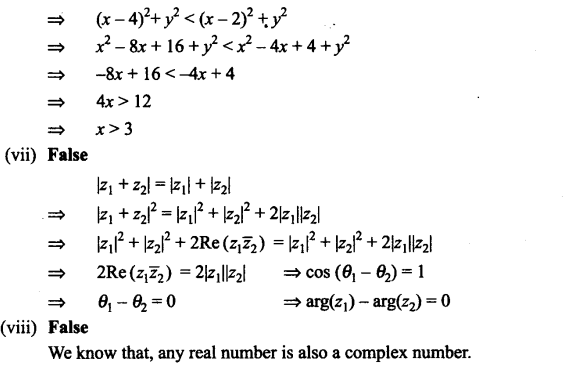
Matching Column Type Questions
Q24. Match the statements of Column A and Column B.
| Column A | Column B | ||
| (a) | The polar form of i + √3 is | (i) | Perpendicular bisector of segment joining (-2, 0) and (2,0) |
| (b) | The amplitude of- 1 + √-3 is | (ii) | On or outside the circle having centre at (0, -4) and radius 3. |
| (c) | It |z + 2| = |z – 2|, then locus of z is | (iii) | 2/3 |
| (d) | It |z + 2i| = |z – 2i|, then locus of z is | (iv) | Perpendicular bisector of segment joining (0, -2) and (0,2) |
| (e) | Region represented by |z + 4i| ≥ 3 is | (v) | 2(cos /6 +I sin /6) |
| (0 | Region represented by |z + 4| ≤ 3 is | (Vi) | On or inside the circle having centre (-4,0) and radius 3 units. |
| (g) | Conjugate of 1+2i/1-I lies in | (vii) | First quadrant |
| (h) | Reciprocal of 1 – i lies in | (viii) | Third quadrant |
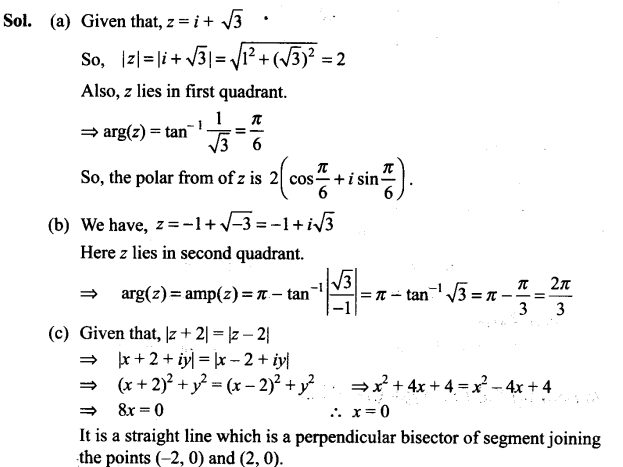
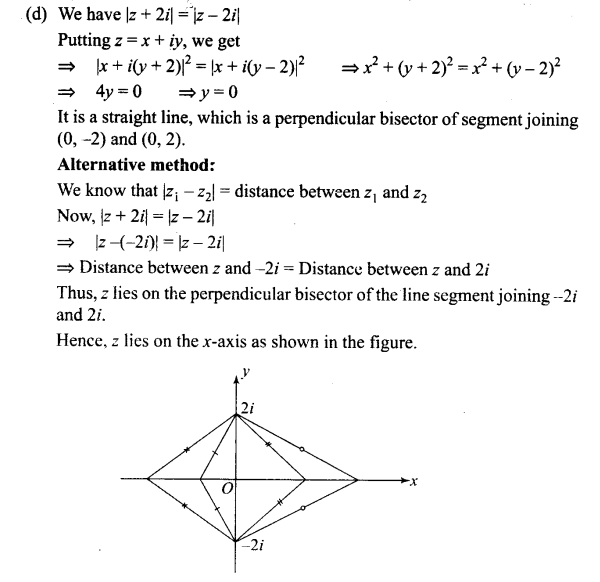
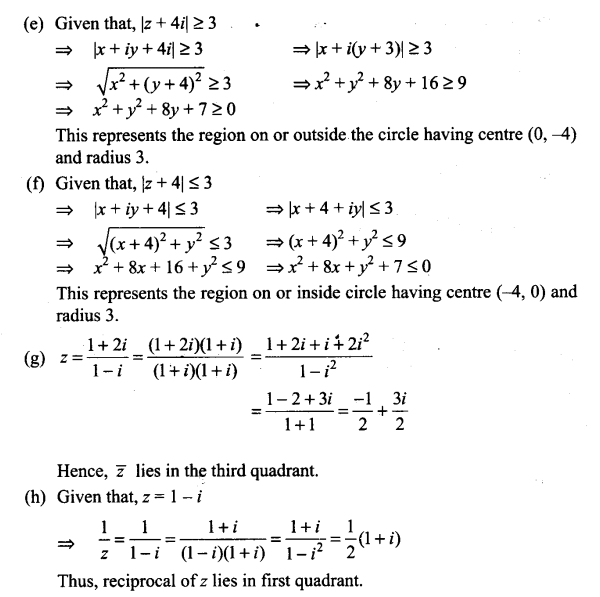
Q28. What is the conjugate of 2-i / (1 – 2i)2

Q29. If |Z1| = |Z2|, is it necessary that Z1 = Z2?
Sol: If |Z1| = |Z2| then z1 and z2 are at the same distance from origin.
But if arg(Z1) ≠arg(z2), then z1 and z2 are different.
So, if (z1| = |z2|, then it is not necessary that z1 = z2.
Consider Z1 = 3 + 4i and Z2 = 4 + 3i
Q30.If (a2+1)2 / 2a –i = x + iy, then what is the value of x2 + y2?
Sol: (a2+1)2 / 2a –i = x + iy

Q31. Find the value of z, if |z| = 4 and arg (z) = 5π/6

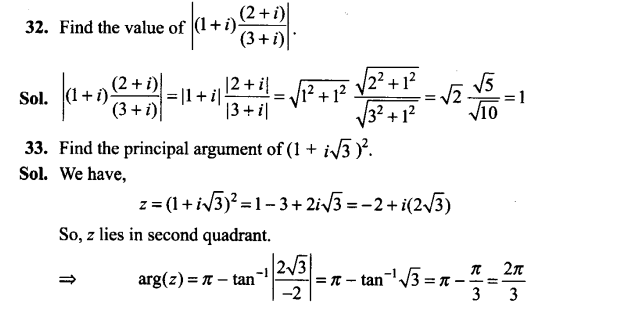
Q34. Where does z lies, if | z – 5i / z + 5i | = 1?
Sol: We have | z – 5i / z + 5i |
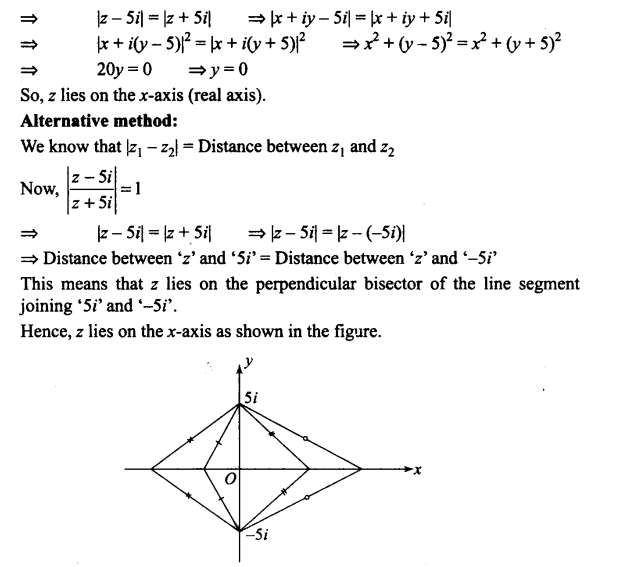
Instruction for Exercises 35-40: Choose the correct answer from the given four options indicated against each of the Exercises.
Q35. sin x + i cos 2x and cos x – i sin 2x are conjugate to each other for
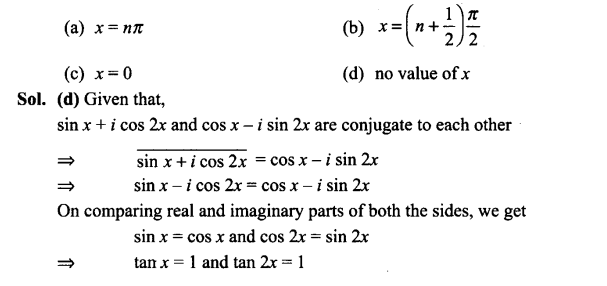

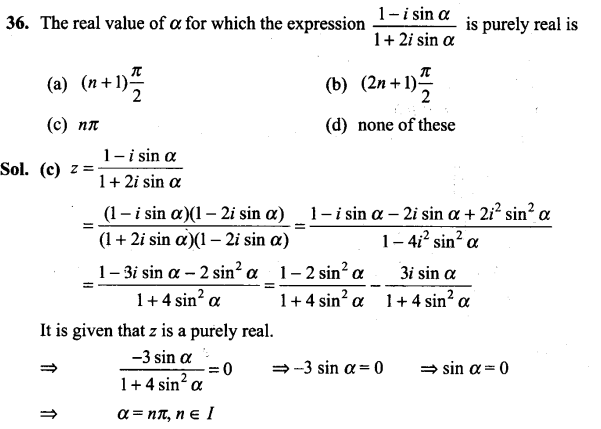

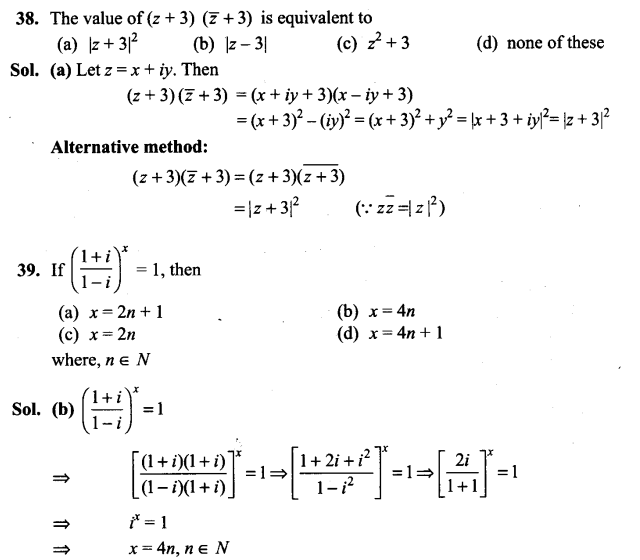
Q41. Which of the following is correct for any two complex numbers z1 and z2?

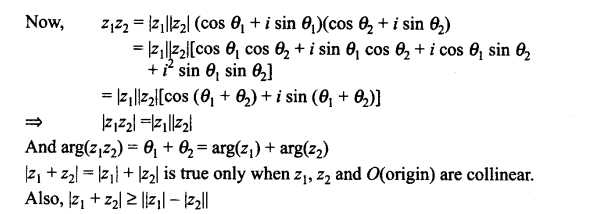
NCERT Exemplar Class 11 Maths Solutions
- Chapter 1 Sets
- Chapter 2 Relations and Functions
- Chapter 3 Trigonometric Functions
- Chapter 4 Principle of Mathematical Induction
- Chapter 5 Complex Numbers and Quadratic Equations
- Chapter 6 Linear Inequalities
- Chapter 7 Permutations and Combinations
- Chapter 8 Binomial Theorem
- Chapter 9 Sequence and Series
- Chapter 10 Straight Lines
- Chapter 11 Conic Sections
- Chapter 12 Introduction to Three-Dimensional Geometry
- Chapter 13 Limits and Derivatives
- Chapter 14 Mathematical Reasoning
- Chapter 15 Statistics
- Chapter 16 Probability
NCERT Exemplar ProblemsMathsPhysicsChemistryBiology
We hope the NCERT Exemplar Class 11 Maths Chapter 5 Complex Numbers and Quadratic Equations help you. If you have any query regarding NCERT Exemplar Class 11 Maths Chapter 5 Complex Numbers and Quadratic Equations, drop a comment below and we will get back to you at the earliest.
<!–
–>